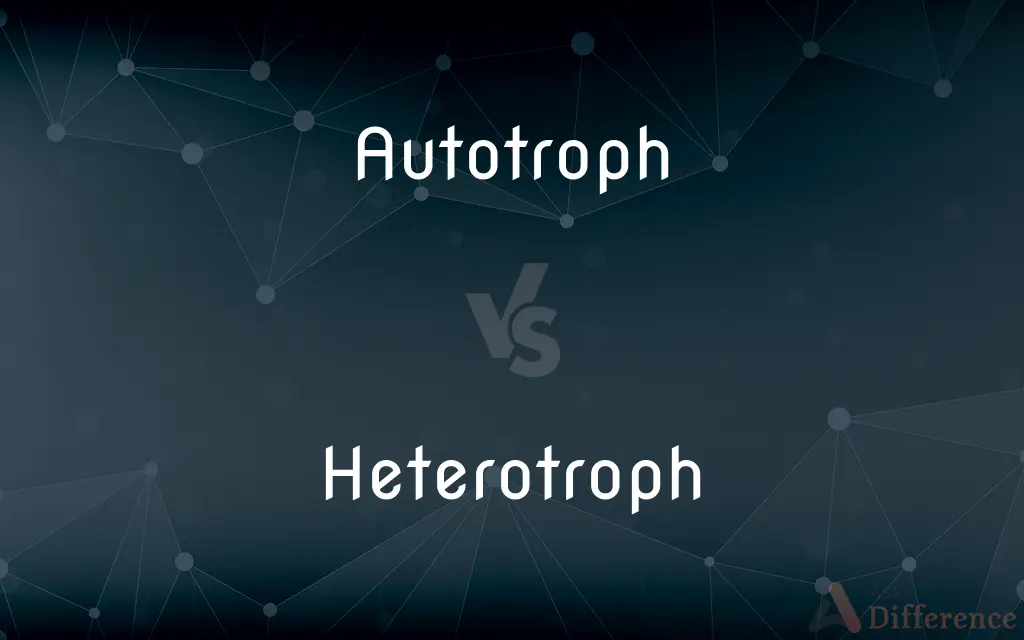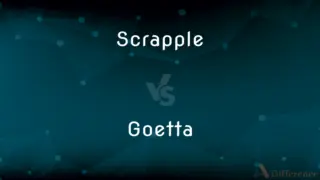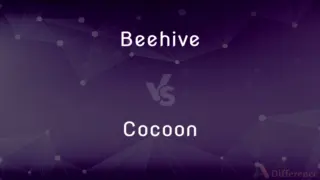Autotroph vs. Heterotroph — What's the Difference?
By Fiza Rafique & Urooj Arif — Updated on March 30, 2024
Autotrophs produce their own food via photosynthesis or chemosynthesis, using light or chemical energy, whereas heterotrophs rely on consuming other organisms for energy.

Difference Between Autotroph and Heterotroph
Table of Contents
ADVERTISEMENT
Key Differences
Autotrophs are organisms that can produce their own food from inorganic substances using light or chemical energy, a capability that supports ecosystems by serving as primary producers. In contrast, heterotrophs cannot synthesize their own food and depend on other organisms, either by consuming them directly or indirectly, to obtain energy and nutrients.
Photosynthesis is a common method among autotrophs, like plants and algae, to convert light energy into chemical energy, producing oxygen as a byproduct. Meanwhile, heterotrophs, such as animals and fungi, consume organic matter to meet their energy requirements, playing roles as consumers, decomposers, or parasites in their ecosystems.
Chemosynthesis is another method used by some autotrophs, like certain bacteria, to produce food by converting inorganic chemical energy from their environment. This contrasts with heterotrophs, which lack the ability to use inorganic sources of energy, thus relying on the organic compounds produced by autotrophs or other heterotrophs.
Autotrophs play a crucial role in carbon fixation, converting CO2 from the atmosphere into organic compounds, thus acting as a primary entry point for carbon into the food web. Heterotrophs, on the other hand, contribute to the carbon cycle by respiring CO2 back into the atmosphere as they metabolize organic compounds.
The distinction between autotrophs and heterotrophs underpins the flow of energy through ecosystems, with autotrophs serving as the foundation upon which heterotrophic organisms depend. This dependency illustrates the interconnectedness of life and the importance of autotrophic processes in sustaining biodiversity.
ADVERTISEMENT
Comparison Chart
Energy Source
Light or chemical energy
Organic compounds (other organisms)
Food Production
Produce their own food
Depend on consuming others
Examples
Plants, algae, some bacteria
Animals, fungi, most bacteria
Role in Ecosystem
Primary producers
Consumers, decomposers
Method of Nutrition
Photosynthesis or chemosynthesis
Ingestion and digestion
Compare with Definitions
Autotroph
Basis of the food chain.
Grasses in a savanna ecosystem provide the energy base for herbivores.
Heterotroph
Depend on autotrophs or other heterotrophs.
Humans consume both plant and animal products.
Autotroph
Use light or chemical energy.
Some bacteria near hydrothermal vents use chemosynthesis.
Heterotroph
Play various ecosystem roles.
Fungi decompose organic matter, recycling nutrients.
Autotroph
Primary producers in ecosystems.
Algae in aquatic environments serve as a food source for various marine species.
Heterotroph
Organisms that consume others for energy.
Lions feed on herbivores in their habitat.
Autotroph
Capable of carbon fixation.
Phytoplankton play a significant role in absorbing CO2 from the atmosphere.
Heterotroph
Cannot fix carbon from the atmosphere.
Animals exhale CO2, which plants then use for photosynthesis.
Autotroph
Organisms that produce their own food.
Plants convert sunlight into energy through photosynthesis.
Heterotroph
Integral to the food web.
Bees, as heterotrophs, pollinate plants while feeding on nectar.
Autotroph
An autotroph or primary producer is an organism that produces complex organic compounds (such as carbohydrates, fats, and proteins) using carbon from simple substances such as carbon dioxide, generally using energy from light (photosynthesis) or inorganic chemical reactions (chemosynthesis). They convert an abiotic source of energy (e.g.
Heterotroph
A heterotroph (; from Ancient Greek ἕτερος héteros "other" and τροφή trophḗ "nutrition") is an organism that cannot produce its own food, instead taking nutrition from other sources of organic carbon, mainly plant or animal matter. In the food chain, heterotrophs are primary, secondary and tertiary consumers, but not producers.
Autotroph
An organism that is able to form nutritional organic substances from simple inorganic substances such as carbon dioxide.
Heterotroph
An organism that is dependent on complex organic substances for nutrition because it cannot synthesize its own food.
Autotroph
An organism capable of synthesizing its own food from inorganic substances, using light or chemical energy. Green plants, algae, and certain bacteria are autotrophs.
Heterotroph
(ecology) An organism which requires an external supply of energy in the form of food as it cannot synthesize its own.
Autotroph
(ecology) Any organism that can synthesize its food from inorganic substances, using heat or light as a source of energy.
Heterotroph
An organism that depends on complex organic substances for nutrition
Autotroph
An organism which is autotrophic, i. e., an organism (such as most plants and certain microorganisms) which are capable of synthesizing its own food from simple organic substances, requiring only minerals as nutrients for growth, and using carbonate or carbon dioxide as a source of carbon and simple inorganic nitrogen as a nitrogen source; the energy required is derived from photosynthesis or chemosynthesis. Opposed to heterotroph. See also auxotroph.
Autotroph
Plant capable of synthesizing its own food from simple organic substances
Common Curiosities
What defines an autotroph?
An autotroph is an organism that can produce its own food from inorganic substances using light or chemical energy.
How do heterotrophs obtain energy?
Heterotrophs obtain energy by consuming organic matter from other organisms.
Are all plants autotrophs?
Most plants are autotrophs, but there are exceptions, like some parasitic plants that rely on other organisms for nutrients.
Can an organism be both an autotroph and a heterotroph?
Some organisms, like certain algae and bacteria, can exhibit both autotrophic and heterotrophic modes of nutrition, depending on environmental conditions.
Why are autotrophs important to the environment?
Autotrophs are crucial for ecosystems as they are the primary producers, forming the base of the food web and enabling the survival of heterotrophs.
Do all autotrophs use photosynthesis?
No, while many autotrophs use photosynthesis, some, particularly certain bacteria, use chemosynthesis.
How do autotrophs and heterotrophs interact?
Autotrophs and heterotrophs interact in the food web, with heterotrophs depending on autotrophs for energy and nutrients.
What is carbon fixation?
Carbon fixation is the process by which inorganic carbon (typically CO2) is converted to organic compounds by living organisms, primarily by autotrophs.
Why are heterotrophs necessary for autotrophs?
Heterotrophs help recycle nutrients and carbon dioxide, which are essential for autotrophic growth and the photosynthetic process.
How do heterotrophs contribute to the carbon cycle?
Heterotrophs contribute by respiring carbon dioxide back into the atmosphere as part of their metabolic processes.
What role do heterotrophs play in ecosystems?
Heterotrophs serve as consumers, decomposers, and sometimes as predators or parasites, helping to maintain ecological balance.
What is chemosynthesis?
Chemosynthesis is a process by which certain autotrophs produce food using chemical energy from inorganic substances, without sunlight.
How does photosynthesis differ from chemosynthesis?
Photosynthesis converts light energy into chemical energy using water and carbon dioxide, releasing oxygen, while chemosynthesis utilizes chemical energy from inorganic substances, without needing sunlight.
Are fungi considered heterotrophs?
Yes, fungi are heterotrophs as they obtain their energy by decomposing organic matter.
Can heterotrophs survive without autotrophs?
Heterotrophs cannot survive without autotrophs, as they depend on the organic matter autotrophs produce for energy.
Share Your Discovery

Previous Comparison
Scrapple vs. Goetta
Next Comparison
Beehive vs. CocoonAuthor Spotlight
Written by
Fiza RafiqueFiza Rafique is a skilled content writer at AskDifference.com, where she meticulously refines and enhances written pieces. Drawing from her vast editorial expertise, Fiza ensures clarity, accuracy, and precision in every article. Passionate about language, she continually seeks to elevate the quality of content for readers worldwide.
Co-written by
Urooj ArifUrooj is a skilled content writer at Ask Difference, known for her exceptional ability to simplify complex topics into engaging and informative content. With a passion for research and a flair for clear, concise writing, she consistently delivers articles that resonate with our diverse audience.














































